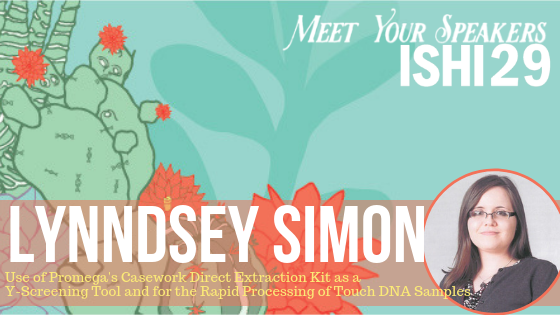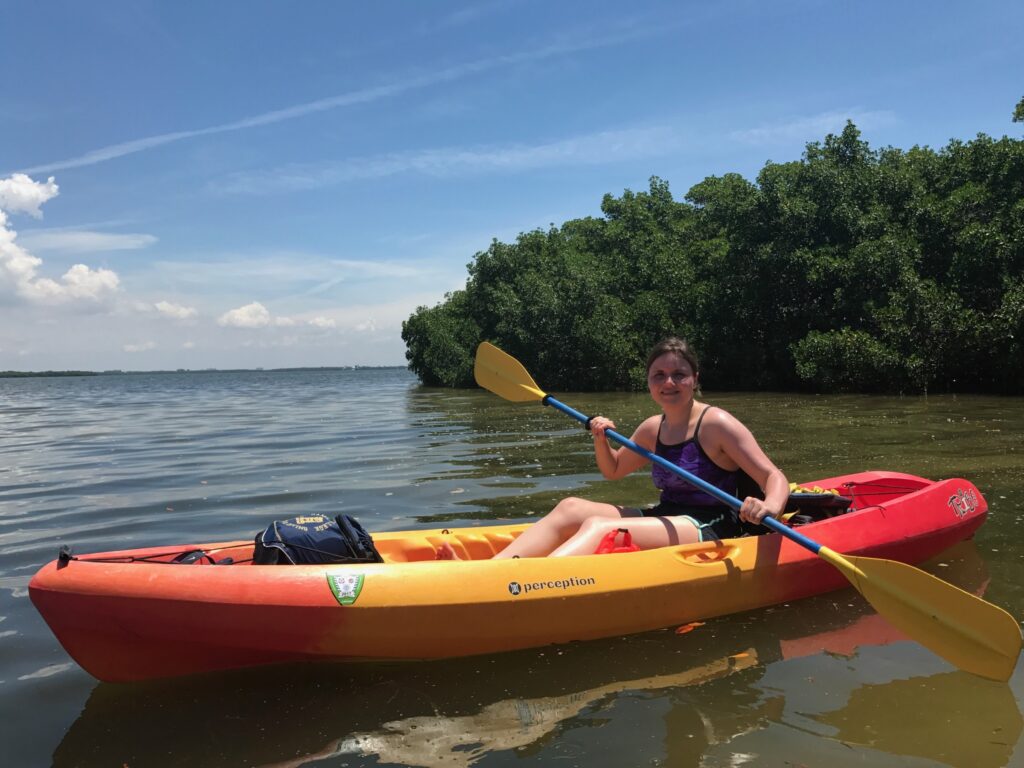Current extraction methods employed by the Columbus Police Forensic Services Center use incubation times that can exceed two hours and require subsequent purification on robotic instrumentation. Promega’s Casework Direct kit allows for the rapid processing of casework samples with no subsequent purification of the lysate required prior to STR amplification.
In her presentation at ISHI, Lynndsey Simon (Columbus Police Forensic Services Center) will describe how her lab is using the Casework Direct Kit to shorten processing times for casework samples and why they’re considering using the kit as the main extraction method for all samples (excluding hairs).
We sat down with Lynndsey and asked her how the Casework Direct Kit has changed her lab’s procedure when processing casework samples, how this has helped to reduce the lab’s backlog, and what she feels are the biggest challenges that forensic laboratories are facing today.
Hi Lynndsey, thanks for chatting with us today. As the backlog continues to be a hot topic, it’s imperative that labs find ways to streamline their processes. Prior to using Promega’s Casework Direct Kit, what was the process like when processing casework samples? How long did this usually take per sample?
Our original procedure was to process every sample that potentially contained semen as a differential. We employ the “direct to DNA” approach to our sexual assault kits (SAKs), so we don’t do any presumptive testing on the swabs in the kit. This was very time-consuming and required a lot of hands-on lab work to perform the manual differentials. And we found most of the samples we treated as a differential didn’t end up needing that type of extraction. We decided to try Casework Direct (CWD) as a possible Y screening tool, to eliminate processing extra differential samples. Before CWD, we could maybe complete a set of 28 differentials within an 8 hour workday. After the manual separation, the samples are added to the Qiagen EZ1 extraction robots, which only hold 14 samples per robot. And each incubation is at least 2 hours; first for the epithelial fraction, and then the sperm fraction.
How has this process changed since bringing the Casework Direct Kit online?
Using CWD, we are able to process a large number of samples in a very short amount of time. We are not limited to the 14 samples per Qiagen EZ1 extraction robot. The incubation time is only 30 minutes versus the ~4 hours that are required for our manual differential procedure. Because of this, we are able to take forward more SAK samples up front. Before we would attempt to limit the sample number to speed up the laboratory processing. But there isn’t a need to limit samples anymore. This is helping to reduce the turnaround time (TAT) for our sexual assault cases. We’ve noticed only a few samples per batch actually require a differential extraction based on the [Auto]/[Y] ratio during quantification. For those few samples, we re-extract them as a differential. Using the CWD to Y-screen has cut down significantly on the amount of differential samples we are processing by quickly determining which samples would benefit from the separation. An [Auto]/[Y] ration of >40 is typically a good indication of this. Less than that, we’ve been able to get enough of the male contributor in the minor to interpret it.
The sexual assault kit backlog continues to be an area of concern for laboratories in the U.S. How many additional samples per day would you guess your lab is able to process since bringing the kit online?
We batch our cases to streamline processing as much as possible. So per batch, we’ve been adding upwards of 100 samples. And these can all be completed in one 30 minute incubation. We’ve expanded the number of thermomixers in our laboratory to accommodate the higher number of samples we are incubating at one time. We don’t currently have a backlog of SAKs; we work them as we receive them. Each sexual assault case has an assigned priority number and we use that number to determine the TAT.
Your abstract also mentions touch DNA samples. How has the Casework Direct Kit helped you in analyzing those samples?
We already use CWD for sexual assault touch samples, either included in the SAK or collected from clothing items. While CWD is supposed to be primarily a screening tool for us, we found through the validation, and now through casework, that we are consistently getting higher quantification values for CWD samples versus our current EZ1 extraction method. There usually isn’t a need to re-extract a CWD touch sample because we weren’t seeing an increased DNA recovery on the EZ1. Because of this, we are currently in the process of validating CWD for use on other sample types, i.e. cigarette butts, bottles/cans, etc. We’ve already validated CWD to process our blood samples and have seen much better recovery and even some better DNA profiles compared to the EZ1. We are also looking into a possible clean-up method using the QIAquick.
What’s next for your lab?
We’ve just finished validating and training our sexual assault team on Qiagen’s QIAcube robot. We are anticipating this will further reduce TAT for the sexual assault cases by making the differential extractions easier and more hands-off. It will mean less time in the lab and more time for other tasks while the robot is performing the separation.
How did you become interested in forensic science?
I started to become interested in forensics during high school, but I can’t remember any specific event that sparked it. I knew I wanted to eventually work in the forensic DNA field, so I researched colleges that had an undergraduate program specifically in forensic science.
What do you feel is the biggest challenge that forensic laboratories are facing today?
Speaking from a smaller laboratory perspective, our biggest challenge is funding. These newer forensic kits (extraction, quantification, amplification, etc.) are all very expensive and we are limited in the amount of funding we receive each year. Yet our laboratory submissions have increased, so we are constantly finding it difficult to keep up with supplying our laboratory. Another challenge we run into is time to work on validation projects. We want to employ newer and more innovative techniques, but it’s difficult to find the time for validations when we need to balance that with casework. We don’t have one specific person dedicated to just validation work, and it’s difficult to justify taking someone off casework when we have a backlog.
What tips would you give to someone who is just starting out in the forensics field, or what is the best advice that you’ve received?
For those just finishing college and looking for a job in the forensic field, I would say don’t be afraid to expand your search to laboratories in other states. It may be difficult to find exactly what you’re looking for if you narrow your search parameters. There are a limited number of jobs available, so it may take a while but don’t be discouraged. After you find a forensic job, don’t be afraid to ask questions. If you’re unsure of what to do, ask your supervisor/another analyst. There are many times I will ask for someone else’s opinion on a case, so collaboration with your co-workers is a big help. Communication is key!
For those still deciding whether to attend, what is your favorite thing about ISHI, or what are you most looking forward to this year?
The exhibits and posters. I enjoy the time we have to talk to different vendors because I always get ideas for trying new procedures or instrumentation that I can bring back to my lab. Same with the posters; I get to interact with a variety of people from different laboratories and always learn something new that I can later apply to my own laboratory.
What’s one thing that others may not know about you?
I really enjoy water-related activities; I used to be a competitive swimmer, but enjoy swimming for the exercise, or kayaking, snorkeling, etc.
WOULD YOU LIKE TO SEE MORE ARTICLES LIKE THIS? SUBSCRIBE TO THE ISHI BLOG BELOW!



